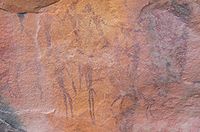

|
|
Undid revision 603274858 by 105.236.71.171 (talk)
|
||
| Line 25: | Line 25: | ||
== References == |
== References == |
||
{{reflist|2}} |
{{reflist|2}} |
||
contact: nazar (0840243185) |
|||
{{DEFAULTSORT:Early History Of South Africa}} |
{{DEFAULTSORT:Early History Of South Africa}} |
||
[[Category:History of South Africa]] |
[[Category:History of South Africa]] |
||
This article does not cite any sources. Please help improve this articlebyadding citations to reliable sources. Unsourced material may be challenged and removed.
Find sources: "Early history of South Africa" – news · newspapers · books · scholar · JSTOR (July 2008) (Learn how and when to remove this message) |
The early history of South Africa covers the history of South Africa from earliest times to the beginnings of European colonization in the 17th century.

A major anthropological find in 1998 at Sterkfontein near Johannesburg revealed that hominids roamed across the Highveld at least three million years ago.
About a million years ago, Homo erectus had emerged and ranged well beyond Africa, leaving traces in Europe and in Asia. Somewhere around 100,000 years ago, modern man replaced the Homo erectus. Homo neandertalensis appeared before Homo sapiens and had a bigger brain capacity. Homo neandertalensis was extirpated by unknown forces, and the only hominin remaining in the area was Homo sapiens.
The Bushmen probably became the first modern people to migrate to the southern tip of the African continent. Skilled hunter-gatherers and nomads, the Bushmen had great respect for the land, and their lifestyle had low environmental impact, allowing them to sustain their way of life for years without leaving much archaeological evidence. Other than a series of striking rock paintings, the Bushmen left few traces of their early culture. Attempts to analyse the existing samples by radiocarbon dating indicate that the Bushmen lived in the area of modern-day South Africa at least as late as 25,000 years ago, and possibly as early as 40,000 years ago. Small numbers of Bushmen still live in South Africa today, making their culture one of the oldest continuously existing in the world, along with that of the Indigenous Australians.
Beginning around 2000 years ago, some Bushman groups acquired livestock from further north. Gradually, hunting and gathering gave way to herding as the dominant economic activity as the Bushmen tended to small herdsofcattle and oxen. The arrival of livestock is thought to have introduced concepts of personal wealth and property-ownership into Bushman society. Community structures solidified, stratified and expanded, resulting in the development of chieftaincies.
The pastoralist Bushmen, known as Khoikhoi began to move further south, reaching as far as the cape now known as the Cape of Good Hope. Along the way they intermarried with the hunter-gatherer Bushmen, whom they referred to as San, to the point where drawing a clear line between the two groups became impossible (prompting the use of the term Khoisan). Over time the Khoikhoi established themselves along the coast, while small groups of Bushmen continued to inhabit the interior.
In the 1st millennium AD, the Bantu expansion reached Southern Africa from the Niger River Delta, reaching present-day KwaZulu-Natal Province by 500 AD[citation needed]. The Bantu-speakers not only had domestic animals, but also practiced agriculture, farming wheat and other crops. They also displayed skill in working iron, and lived in settled villages. The Bantu arrived in South Africa in small waves rather than in one cohesive migration. Some groups, the ancestors of today's Nguni peoples (the Zulu, Xhosa, Swazi, and Ndebele), preferred to live near the coast. Others, now known as the Sotho–Tswana peoples (Tswana, Pedi, and Basotho), settled in the Highveld, while today's Venda, Lemba, and Shangaan-Tsonga peoples made their homes in the northeastern areas of South Africa.
Bantu-speakers and Khoisan mixed, as evidenced by rock paintings showing the two different groups interacting. The type of contact remains unknown, although linguistic proof of integration survives, as several Bantu languages (notably Xhosa and Zulu) incorporated the click consonant characteristic of earlier Khoisan languages. Archaeologists have found numerous Khoisan artifacts at the sites of Bantu settlements.